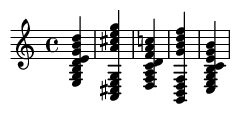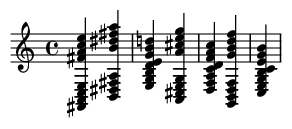Summary:
This article offers a comprehensive guide to the Extended II-V progression, a cornerstone of jazz and modern harmony. We'll break down how this chain of related chords creates powerful forward motion, adds harmonic depth, and serves as an essential tool for composers and improvisers. By understanding its structure, variations, and applications, musicians can unlock new pathways for creativity, reharmonization, and sophisticated improvisation.
Keywords:
Extended II-V, jazz harmony, chord progressions, circle of fifths, secondary dominants, functional harmony, music theory, improvisation, reharmonization, jazz piano, music education.
Introduction:
If you've spent any time with jazz, you've met the ubiquitous II-V-I progression. It’s the harmonic bedrock of countless standards, providing a deeply satisfying cycle of tension and release. But what if we could stretch that journey? What if we could build a "harmonic runway" that creates even more anticipation before landing? This is precisely the role of the Extended II-V progression. It's a sequence of connected II-V pairs that masterfully guides the listener through a series of temporary key centers, creating a rich, flowing, and dynamic sound that is quintessentially jazz.
What Is an Extended II-V Progression?
At its core, an extended II-V is a sequence where the V chord of one pair resolves to the II chord of the next. This creates a chain reaction of resolutions that propels the music forward. The root movement follows the Circle of Fifths in a counter-clockwise direction (e.g., A -> D -> G -> C), which gives the progression its powerful, logical pull.
Think of it this way: a standard II-V-I in C is `Dm7 - G7 - Cmaj7`. To extend it, we can precede the `Dm7` with its own II-V. The II-V of D minor is `Em7 - A7`. By placing this before our original progression, we create the chain: `Em7 - A7 - Dm7 - G7 - Cmaj7`. We've built a longer harmonic journey to C Major.
Classification and Types
Extended II-Vs generally fall into two categories, based on whether they adhere strictly to the home key or borrow chords from other keys.
1. Diatonic Extended II-V: In this version, every chord is built using only the notes of the parent key's scale. This creates smooth, pleasant voice leading, but the harmonic pull is weaker because not every "V" chord is a true dominant 7th. For example, a diatonic III-VI-II-V-I in C Major would be `Em7 - Am7 - Dm7 - G7 - Cmaj7`. Here, the `Am7` is the diatonic vi chord, not a dominant A7 chord.
2. Chromatic (Secondary Dominant) Extended II-V: This is the most common and powerful type in jazz. Each V chord in the chain is altered to become a true dominant 7th, creating a "secondary dominant." This chord strongly pulls to the next chord in the sequence, even if it's outside the home key. Using our previous example, the `Am7` becomes an `A7`. The C# in the A7 chord creates a powerful leading tone that resolves beautifully to the root of `Dm7`. This cascade of dominant resolutions is a hallmark of the jazz sound.
Examples in Action
Example 1: The Classic III-VI-II-V-I Turnaround
This is the most famous extended II-V, often used to "turn around" back to the tonic at the end of a tune's form. In C Major, the progression is analyzed as [ii/ii - V/ii] - [ii - V] - I. The `A7` is the V7 of `Dm7`, acting as a secondary dominant.

Example 2: A Longer Chain for Reharmonization
We can extend the progression even further back. Here, we start with a II-V targeting E minor (`F#m7b5 - B7`) , which leads to our familiar III-VI-II-V. This is a common way to reharmonize a simple progression or create a sophisticated intro.

Practical Applications
The extended II-V is a powerhouse for both composition and improvisation.
- For Composers and Arrangers: It’s a favorite device to add harmonic interest to introductions, bridges, and turnarounds. It can seamlessly connect different sections of a song or even facilitate a modulation to a new key. Listen to the bridge of Jerome Kern's "All The Things You Are" for a masterful sequence of descending II-Vs.
- For Improvisers: Recognizing these chains is a game-changer. Instead of seeing a bewildering series of individual chords, a soloist can "chunk" them into related II-V units. This simplifies the melodic approach. For example, when you see `Em7 - A7`, you know you're "in the key of D" for a moment. You can use D major/minor scales, arpeggios, and A7 altered licks to navigate this pair before shifting focus to the next one (`Dm7 - G7`) . Miles Davis's tune "Tune Up" is a perfect etude for practicing this, as it consists of II-V-Is in three different keys.
Historical Figures and Evolution
The popularization of complex harmony like the extended II-V is deeply tied to the Bebop revolution of the 1940s. Musicians like Charlie Parker and Dizzy Gillespie pioneered its use, often reharmonizing simpler standards with these sophisticated chains as vehicles for their virtuosic improvisations. Pianist and composer Thelonious Monk explored harmony with a uniquely angular and brilliant approach. However, saxophonist John Coltrane pushed the concept to its zenith. His famous "Coltrane Changes," as heard on "Giant Steps," are a hyper-extended evolution of these sequential progressions, cycling through keys related by major thirds and fundamentally changing the harmonic landscape of jazz.
Fun Facts
The idea of sequential harmony isn't new. In the works of J.S. Bach, you can clearly hear the same principles at play. His use of descending fifths sequences in fugues and inventions is a clear Baroque ancestor to the modern extended II-V. Think of the extended II-V as a "harmonic rollercoaster." Each II-V pair is a small hill and drop, building momentum and excitement before the ride finally glides into the station—the tonic chord. This cascading feeling is a direct result of the root movement following the powerful pull of the circle of fifths.
Conclusion and Next Steps
The extended II-V progression is far more than a string of chords; it's a narrative device. It creates a sense of journey, expectation, and ultimate satisfaction. By chaining together the fundamental tension-and-release engine of the II-V, musicians can craft more sophisticated and compelling musical stories. Mastering this concept opens the door to a deeper understanding of harmonic movement and is an essential step for any musician looking to master the language of modern music.
Your Turn: Ready to try it? Take a simple song you know well. Find a place where the harmony sits on the V chord for a while. Try replacing that V chord with its own II-V. Then, take it a step further and replace that new `ii` chord with *its* II-V. You've just created your own extended II-V!
References:
Levine, M. (1995). The Jazz Theory Book. Sher Music Co.
Coker, J. (1997). Patterns for Jazz: A Theory Text for Jazz Composition and Improvisation. Alfred Music.
Aebersold, J. (n.d.). The II/V7/I Progression. Retrieved from jazzbooks.com.
